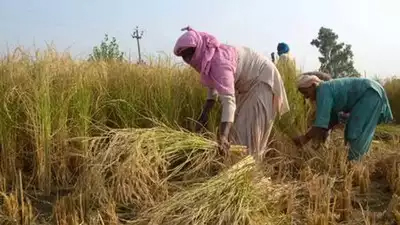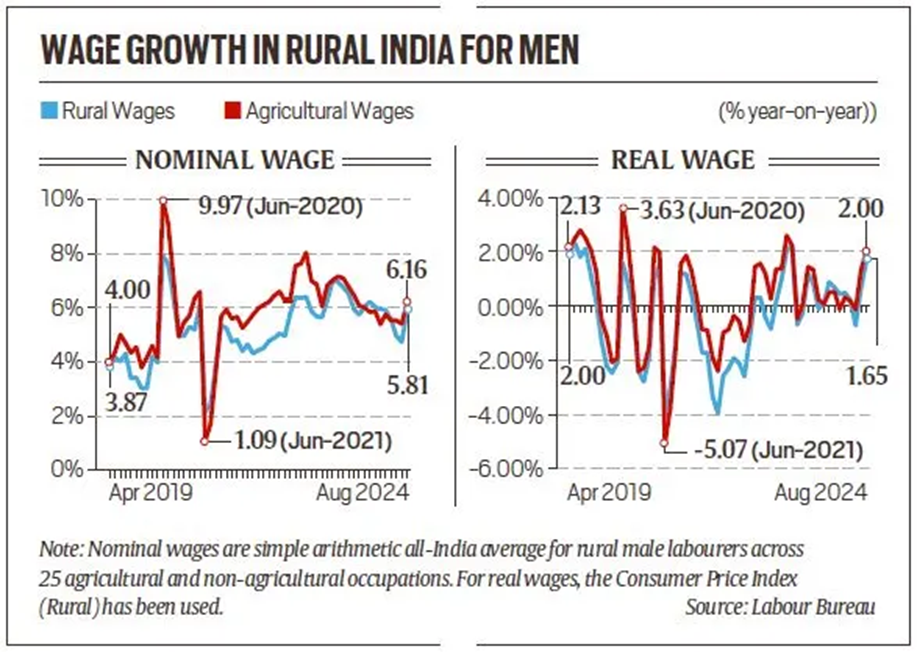Context:
Despite notable growth in India's Gross Domestic Product (GDP) and significant expansion in the agricultural sector, rural wages have stagnated in recent years. From 2019-20 to 2023-24, the Indian economy has averaged an annual growth rate of 4.6%, with a substantial increase of 7.8% in GDP over the last three years. The agricultural sector has also seen growth rates of 4.2% over the five-year period and 3.6% recently. However, this economic progress has not resulted in corresponding increases in rural wages. According to the Labour Bureau, real wage growth for rural workers stands at only 0.5% for the current fiscal year. This disconnect between economic growth and wage stagnation highlights critical issues within rural labor markets and raises important questions for policymakers focused on achieving inclusive growth that benefits all segments of society, particularly those in rural areas.
Rural Wage Trends and Data Insights:
The Labour Bureau tracks daily wage rates across 25 agricultural and non-agricultural occupations, providing insights into nominal (current value) and real (inflation-adjusted) wage growth. The key data reveals:
- Overall Rural Wage Growth: Nominal wage growth averaged 5.2% annually from 2019-20 to 2023-24, yet real wage growth turned negative at -0.4%.
- Agricultural Wage Growth: Nominal growth in agricultural wages was slightly better at 5.8%, with real wage growth at a marginal 0.2%.
- Current Fiscal Trends (April-August 2023): Nominal growth in rural wages reached 5.4%, but real wage growth remained low at 0.5%.
Why Rural Wages Aren't Growing?
1. Rising Labour Force Participation Rate (LFPR) Among Rural Women:
o Rural female LFPR surged from 26.4% in 2018-19 to 47.6% in 2023-24, largely driven by government initiatives like Ujjwala, Har Ghar Jal, and Swachh Bharat, which have reduced household labor and freed up time for women to pursue paid work.
o Although increased female participation has expanded the rural workforce, this larger labor supply has exerted downward pressure on wages, as more individuals are willing to work at the same or lower pay.
2. Less Labour-Intensive Economic Growth:
o Despite more women entering the labor force, most are finding work in agriculture rather than higher-paying non-farm roles. Agriculture’s share in rural female employment rose from 71.1% to 76.9% between 2018-19 and 2023-24.
o Capital-intensive growth, particularly in sectors requiring fewer workers per unit of output, has driven recent economic expansion, limiting demand for rural labor and dampening wage growth.
3. Demand Shift and Consumer Impact:
o Capital-intensive, investment-driven growth benefits sectors like cement, steel, and infrastructure, but it has limited benefits for fast-moving consumer goods, home appliances, and two-wheeler manufacturers. These sectors, which rely on labor-intensive and consumption-led growth, are impacted when rural wages and consumption remain low.
Reasons for Economic Growth Not Corresponding with Sufficient Job Creation:
· Premature Deindustrialization: India is experiencing premature deindustrialization, where the manufacturing sector’s share in GDP and employment is declining at a much lower income level than in developed countries.
· Skill Gap Issue: There exists a notable disparity between the skills required by employers and those that workers currently possess. Despite efforts like the Skill India initiative, these programs have fallen short of their goals, resulting in high rates of both unemployment and underemployment.
· Prevalence of Informal Employment: More than 90% of India’s workforce is engaged in the informal sector, which is marked by low productivity, a lack of job security, and minimal social protection. Although the gig economy presents new employment opportunities, it often lacks stability and career advancement prospects, exacerbating job insecurity.
· Challenge in Job Creation and Rising Working Population: With approximately 12 million new individuals joining the workforce each year, India must create 10-12 million jobs annually to harness its demographic dividend and prevent it from becoming a demographic liability. However, the current rate of job creation is insufficient, posing a risk of social unrest and economic challenges.
· ‘Missing Middle’ in MSMEs: India’s industrial structure is polarized between very small firms and large corporations, with a lack of mid-sized enterprises that are typically most effective at generating employment. The MSME sector, crucial for job creation, continues to struggle following demonetization and the COVID-19 pandemic.
· Job Loss Due to AI and Automation: The rise of automation and AI is reshaping job markets, with the potential to displace up to 9% of India’s workforce by 2030. These advancements typically demand a highly skilled workforce, which could increase unemployment rates among lower-skilled workers.
· Misalignment of Academic Curriculums with Industry Needs: India’s education system does not adequately prepare students for modern job markets, leading to a situation where only 47% of graduates were employable in 2019. This mismatch creates inefficiencies, with a significant number of job seekers unable to meet industry demands.
Strategies to Make Economic Growth More Labor-Intensive:
1. Lowering Wage-Rental Ratio: To promote labor-intensive growth, policies should lower the wage-rental ratio, making labor cheaper relative to capital. However, lowering wages is not feasible in India due to already low wage levels.
2. Focus on Labor-Intensive Sectors: Labor-intensive sectors like construction, trade, transport, and textiles, which currently employ about 240 million people, could benefit from a shift in resource allocation if the wage-rental ratio is reduced.
3. Employment-Linked Incentives: Implementation of a robust employment-linked incentive (ELI) scheme, similar to the Production-Linked Incentive (PLI), to promote job creation in labor-intensive sectors.
4. Addressing Labor Market Rigidities: Simplify labor laws and reduce the compliance burden, which currently hinders employment growth, by drawing on comparative evidence from different states.
5. Raising the Cost of Capital: In India, government-controlled low capital costs, influenced by artificially low interest rates, fail to reflect true scarcity. Raising capital costs could shift focus towards more labor-intensive sectors, promoting job creation.
6. Adjusting Exchange Rates: Adjust exchange rates to make imports more expensive and exports cheaper, though this could lead to accusations of currency manipulation.
Conclusion:
India’s economic growth has not yet translated into substantial wage gains for rural laborers, especially women. Rising female labor force participation, capital-intensive growth, and low non-farm job availability in rural areas have all contributed to this wage paradox. While income transfer schemes provide temporary relief, a sustained boost in rural wages will likely require creating diverse employment opportunities beyond agriculture, emphasizing labor-intensive sectors, and ensuring that economic growth is inclusive and beneficial across all sectors.
|
Probable questions for UPSC Mains exam: Analyze the role of skill development programs in bridging the gap between labor market requirements and workforce skills in rural India. What challenges do these programs face in achieving their objectives? |








